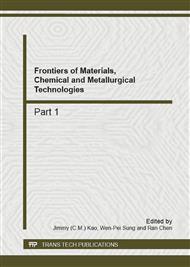p.790
p.794
p.798
p.803
p.808
p.819
p.823
p.827
p.831
Effect of Filler Alloy on Microstructure, Mechanical and Corrosion Behaviour of Dissimilar Weldment between Aisi 201 Stainless Steel and Low Carbon Steel Sheets Produced by a Gas Tungsten Arc Welding
Abstract:
The joining of austenitic stainless steel (AISI 201) to low carbon steel sheets (CS) was attempted by gas tungsten arc welding (GTAW) with four types of consumables. The studied consumables were ER308L, ER309L, ER316L stainless steel wires, and AWS A5.18 carbon steel wire. The welding parameters – i.e. the current of 90 A and the welding speed of 62 mm.min-1 – were fixed in all welding operations. The microstructure of weld metal produced by stainless steel consumables consisted of delta ferrite in austenite matrix. The delta ferrite in the form of continuous dendrite was observed in weld metals produced by 308L and 309L fillers. The dendrite of delta ferrite was relatively discontinuous in weld metal produced by 316L filler. The microstructure of weld metal produced by carbon steel filler consisted of equiaxed ferrite and pearlite, similar to that of carbon steel. The corrosion behavior of weld metal was investigated by potentiodynamic method. Specimens were tested in 0.35-wt% NaCl solution saturated by laboratory air at 27°C. It was found that the corrosion potential of weld metal produced by carbon steel filler was considerably lower than those of AISI 201 base metal and weld metals welded using stainless steel consumables. Weld metals produced by stainless steel fillers –308L,309L and316L– exhibited the similar corrosion potentials as that of 201 base metal. The pitting potentials of weld metals produced by 309L, 316L fillers were higher than those of 201 base metal and weld metal produced by 308L filler respectively. It was discussed that the increase of Cr content in weld metals by using 309L filler contained with 24.791 wt% of Cr, or the addition of Cr and Mo in weld metals by using 316L filler contained with 21.347 wt% of Cr and 2 wt% of Mo, promoted the pitting corrosion resistance of weld metal to be comparable with that of Fe-17Cr-3Ni (201) base metal. An emission spectroscopy was applied to quantify the amount of elements in weld metals. By considering the contents of Cr and Mo, the pitting resistance equivalent number (PREN) of each weld metal was calculated. The discussion of the corrosion resistance of weld metals related to PREN and microstructure was made in the paper.
Info:
Periodical:
Pages:
808-816
Citation:
Online since:
October 2012
Authors:
Price:
Сopyright:
© 2012 Trans Tech Publications Ltd. All Rights Reserved
Share:
Citation:


